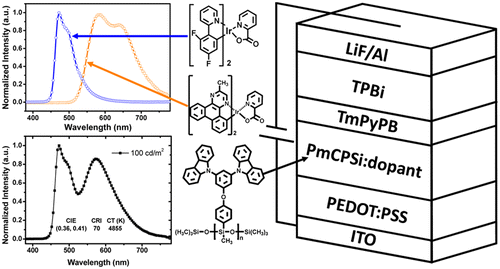
Solution-Processed Blue/Deep Blue and White Phosphorescent Organic Light-Emitting Diodes (PhOLEDs) Hosted by a Polysiloxane Derivative with Pendant mCP (1,3-bis(9-carbazolyl)benzene)
Dianming Sun, Xiaokang Zhou, Junteng Liu, Xiaoli Sun, Huihui Li, Zhongjie Ren, Dongge Ma, Martin R. Bryce and Shouke Yan
Abstract : The synthesis and characterization is reported of an efficient polysiloxane derivative containing the 1,3-bis(9-carbazolyl)benzene (mCP) moiety as a pendant unit on the polysiloxane backbone. In comparison with mCP, the mCP-polysiloxane hybrid (PmCPSi) has significantly improved thermal and morphological stabilities with a high decomposition temperature (Td = 523 °C) and glass transition temperature (Tg = 194 °C). The silicon–oxygen linkage of PmCPSi prevents intermolecular π-stacking and ensures a high triplet energy level (ET = 3.0 eV). Using PmCPSi as a host, blue phosphorescent organic light emitting devices (PhOLEDs) effectively confine triplet excitons, with efficient energy transfer to the guest emitter and a relatively low turn-on voltage of 5.8 V. A maximum external quantum efficiency of 9.24% and maximum current efficiency of 18.93 cd/A are obtained. These values are higher than for directly ****ogous poly(vinylcarbazole) (PVK) based devices (6.76%, 12.29 cd/A). Good color stability over a range of operating voltages is observed. A two-component “warm-white” device with a maximum current efficiency of 10.4 cd/A is obtained using a blend of blue and orange phosphorescent emitters as dopants in PmCPSi host. These results demonstrate that well-designed polysiloxane derivatives are highly efficient hosts suitable for low-cost solution-processed PhOLEDs.
